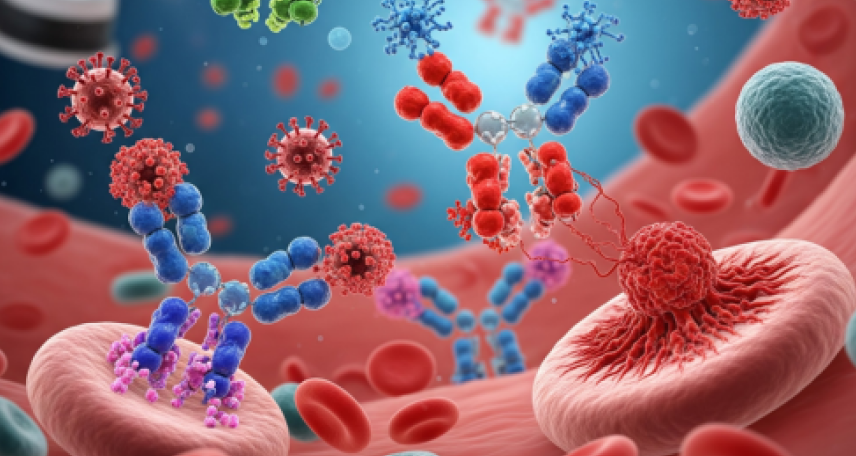by Team Pharma Now
8 minutes
How Monoclonal Antibodies Help Study Apoptosis Pathways?
Learn how mAbs illuminate apoptosis pathways to study cell death and develop therapies.

Cells are the building blocks of the body. However, they have a lifespan. So, when cells become unnecessary or damaged, it is crucial for them to die. Otherwise, they can cause a significant harm to your body, leading to:
- Cancer
- Autoimmune disorders
- Neurodegenerative conditions
The body has a biological process that involves a series of signalling pathways that eliminate damaged or unnecessary cells to maintain tissue homeostasis without any inflammation. This process is known as apoptosis or programmed cell death. It ensures that the cells die safely and in a controlled manner.
Apoptosis helps:
- Maintain tissue health and balance
- Prevent the spread of DNA damage or mutations
- Shape organs and tissues during development
- Eliminate infected or abnormal cells
- Prevent autoimmune reactions
- Avoid inflammation and tissue damage
Apoptosis is regulated via two main pathways:
- Intrinsic Pathway (Mitochondrial Pathway): Triggered by internal stress signals such as DNA damage, oxidative stress, or oncogene activation. This pathway involves the release of cytochrome c from mitochondria, activation of caspases, and regulation by Bcl-2 family proteins.
- Extrinsic Pathway (Death Receptor Pathway): Initiated by extracellular death signals like Fas ligand (FasL) or tumor necrosis factor (TNF). These signals bind to death receptors on the cell surface and activate caspase-8 and subsequent downstream effectors.
Note: Key regulatory proteins, such as p53, Bcl-2, Bax, Caspase-3, and Fas, ensure that apoptosis occurs only when necessary. Abnormalities in these pathways often lead to uncontrolled cell proliferation or premature cell death.
In order to develop new diagnostic and therapeutic strategies, scientists study apoptosis pathways via monoclonal antibodies.
What are Monoclonal Antibodies?
Monoclonal antibodies (mAbs) are laboratory-produced molecules that identify and bind to the same region of the epitope. These antibodies are designed from a single type of immune cell. They are known for their high specificity.
The production of monoclonal antibodies involves several steps, including:
- Immunization
- Harvesting B cells
- Hybridoma formation
- Screening and selection
- Purification
In apoptosis, mAbs bind to apoptosis-related proteins that help scientists to visualize, quantify, and manipulate these molecules in various biological systems.
This helps:
- Recognize cleaved caspases, Annexin V, or other apoptosis proteins in tissue samples and cell cultures.
- Identify the location of apoptosis-related proteins, such as p53 and Bcl-2.
- Understand protein-protein interactions and how apoptosis pathways are regulated.
- Discover how anti-cancer drugs inhibit apoptotic pathways and develop new targeted therapies.
For instance:
The p53 protein, often referred to as the "guardian of the genome," plays a crucial role in apoptosis. It senses DNA damage and triggers cell death when repair is impossible. Mutations in the TP53 gene are found in more than half of all human cancers. This leads to impaired apoptosis and uncontrolled cell proliferation.
At times, scientists use an anti-p53 antibody to:
- Detect Mutant and Wild-Type p53
- Monitor Apoptotic Response
- Diagnose Cancer
What is the Role of Monoclonal Antibodies in Apoptosis Research?
Detect Apoptosis Proteins
mAbs can bind to specific proteins that appear only during apoptosis. For example, cleaved caspase-3 is a protein that becomes active when a cell is undergoing apoptosis.
By using a monoclonal antibody against cleaved caspase-3, scientists can detect which cells are dying. This helps them understand how apoptosis is triggered in different conditions.
Locate Proteins in Cells
Some proteins move to different parts of the cell during apoptosis. For example, cytochrome c moves from the mitochondria to the cytoplasm to activate caspases. Monoclonal antibodies can be tagged with fluorescent markers. This allows researchers to see exactly where these proteins are inside the cell. This helps them map the steps of apoptosis.
Measure Protein Levels
Monoclonal antibodies can be used in techniques like ELISA or Western blot to measure how much of a protein is present. For example, Bcl-2 is an anti-apoptotic protein. High levels of Bcl-2 can prevent cells from dying. So, scientists measure Bcl-2 levels with mAbs to understand why some cells resist apoptosis.
Study Protein Interactions
Proteins in apoptosis pathways often interact with each other. Monoclonal antibodies can help pull down one protein and see what other proteins are attached. This technique is called immunoprecipitation. This technique helps researchers figure out how apoptosis is controlled and regulated.
Test Drugs and Therapies
Many cancer treatments work by inducing apoptosis in cancer cells. Monoclonal antibodies can be used to monitor whether these treatments activate the apoptosis pathways. For example, an anti-Bax antibody can show whether the Bax protein moves to mitochondria after a drug treatment. This helps design better anti-cancer therapies.
The Bottom Line
Monoclonal antibodies are like precise tools that illuminate the hidden details of apoptosis. They allow scientists to detect, locate, measure, and study proteins that control cell death.
This knowledge helps in understanding diseases, developing therapies, and designing better drugs. Without these antibodies, apoptosis research would be much slower and less accurate. However, make sure you buy mAbs from a reliable source for your experiments.




